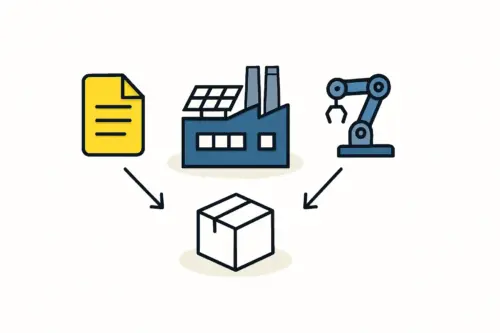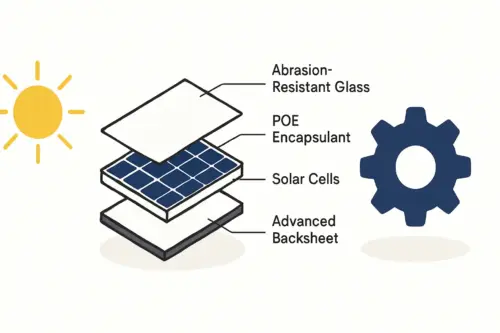For international entrepreneurs exploring Africa’s vast solar potential, attention often gravitates toward the continent’s largest economies. Yet some of the most compelling business cases lie in countries with a strategic combination of high solar irradiation and robust government support. Namibia, with its stable political environment and clear industrial policy, presents such an opportunity, particularly for those looking to establish solar module manufacturing operations.
The country has implemented a series of powerful tax incentives designed to attract manufacturers. For a prospective solar producer, these programs are not minor benefits; they are foundational advantages that can significantly reduce initial capital expenditure and improve long-term profitability.
This guide provides a practical overview of Namibia’s key incentive structures, outlining their benefits, qualification criteria, and the application process.
Understanding Namibia’s Strategic Vision for Manufacturing
Namibia’s government incentives are rooted in a long-term economic strategy known as Vision 2030. This policy aims to diversify the national economy beyond its traditional reliance on mining and tourism. By fostering a strong industrial and manufacturing base, the government seeks to create skilled jobs, increase foreign exchange earnings through exports, and enhance national energy security.
Government bodies like the Namibia Investment Promotion and Development Board (NIPDB) are tasked with facilitating and supporting foreign direct investment. For solar manufacturers, this creates a supportive regulatory environment where the state’s objectives align directly with the investor’s business goals. This alignment provides a degree of stability and predictability that is highly valued in any emerging market.

Key Incentive Programs for Solar Module Manufacturers
Two primary legislative frameworks underpin Namibia’s manufacturing incentives. While both offer substantial benefits, they are designed for slightly different business models. A clear understanding of each is essential to developing a sound business plan.
The Special Incentives for Manufacturers and Exporters
This program is designed for companies that plan to manufacture goods within Namibia and export a significant portion of their production. It offers a balanced set of benefits ideal for a solar module factory serving both regional export markets and the growing domestic Namibian market.
Core Benefits:
- Reduced Corporate Income Tax: Qualifying manufacturers are taxed at a reduced rate of 18% for a period of ten years. This is a substantial reduction from the standard corporate tax rate of 32%.
- VAT Exemption on Capital Equipment: The Value-Added Tax (VAT), which stands at 15%, is waived on the importation or purchase of manufacturing machinery and equipment. This directly lowers the upfront cost of setting up a solar module production line, preserving capital for other operational needs.
- Enhanced Training Cost Deductions: To encourage local skills development, companies can deduct up to 125% of the costs incurred for training Namibian employees.
Qualification Criteria:
Ready to make big Profits?
The solar Industry is Booming
WE HELP NEWCOMERS to the solar industry start their own solar module production line. Customers can make BIG PROFITS by selling modules and finding investors, without wasting money and time on things they don't need!
To be eligible, a business must be formally registered as a manufacturer with the Ministry of Industrialisation and Trade. The application requires a detailed business plan demonstrating commercial viability, export potential, and projected contributions to local employment. Experience from J.v.G. turnkey projects in Southern Africa confirms a well-structured plan is the most critical component of a successful application.
The Export Processing Zone (EPZ) Regime
The EPZ regime is a more aggressive incentive scheme intended for businesses that are almost exclusively export-oriented. Companies operating under an EPZ certificate benefit from a near-total exemption from taxes and duties, making it a powerful tool for manufacturers targeting international markets from a Namibian base.
Core Benefits:
- Corporate Tax Exemption: EPZ-certified enterprises are completely exempt from paying corporate income tax.
- Full Duty Exemption: No customs or excise duties are levied on the importation of capital equipment, raw materials, or any other goods required for the manufacturing process.
- Exemption from Other Taxes: EPZ companies are also exempt from VAT, stamp duties, and transfer duties on goods and services.
Qualification Criteria:
The primary condition for EPZ status is that the business must export at least 80% of its manufactured goods outside the Southern African Customs Union (SACU) region. Selling into the local or SACU market is generally not permitted without special approval, which would involve paying the standard duties and taxes on those specific sales. This makes the EPZ an excellent choice for a producer with established export channels to Europe, the Americas, or other parts of Africa.

The Application Process: A Step-by-Step Overview
The application process for these incentives is structured and, while meticulous, follows logical steps set by Namibian authorities.
-
Company Registration: The first step is to register a legal business entity in Namibia through the Business and Intellectual Property Authority (BIPA).
-
Preparation of the Application Dossier: This is the most intensive phase. The application package must include a comprehensive business plan, detailed financial projections, proof of funding, technical specifications of the planned factory, and market analysis.
-
Submission to Authorities: The completed application is then submitted to the Ministry of Industrialisation and Trade, often in coordination with the NIPDB, which serves as the primary point of contact for foreign investors.
-
Review and Due Diligence: The relevant government committees review the application. This review typically takes three to six months and can include requests for additional information or clarification.
-
Issuance of Certificate: Upon approval, the ministry issues a certificate confirming the company’s status as a registered Manufacturer or an EPZ Enterprise, which officially grants access to the associated benefits.
A Practical Example: The Impact on a 50 MW Solar Factory
To understand the tangible financial impact of these incentives, consider a hypothetical 50 MW solar module factory with an initial capital investment of USD 5 million in machinery.
| Without Incentives | With Manufacturer Incentives | With EPZ Status | |
|---|---|---|---|
| Upfront VAT on Machinery | USD 750,000 (at 15%) | USD 0 | USD 0 |
| Annual Corporate Tax | 32% on taxable profits | 18% on taxable profits | 0% on taxable profits |
| Immediate CAPEX Saving | – | USD 750,000 | USD 750,000 |
As this comparison illustrates, the incentives immediately reduce the initial capital required by three-quarters of a million dollars. Over the life of the project, the savings on corporate tax under either scheme create a significant competitive advantage and drastically improve the return on investment. This is precisely the kind of aha moment that transforms a project from being merely feasible to highly attractive.

Navigating Common Challenges
While the Namibian incentive framework is well-regarded, prospective investors should be prepared to navigate a few common challenges:
- Bureaucratic Thoroughness: The application review process is exceptionally detailed, and incomplete or poorly justified business plans are a common source of delays.
- Ongoing Compliance: Receiving incentive status is not a one-time event. Companies must adhere to strict reporting requirements to demonstrate they continue to meet the qualification criteria, especially regarding export targets and employment.
- Logistical Planning: While Namibia has excellent infrastructure, including the deep-water port of Walvis Bay, logistical planning for importing raw materials and exporting finished modules is a critical operational detail to address in the business plan.
Engaging with consultants who have direct experience in the region can help anticipate and mitigate these challenges, ensuring a smoother path from planning to production.
Frequently Asked Questions (FAQ)
Can a 100% foreign-owned company qualify for these incentives?
Yes. Namibia’s investment laws permit full foreign ownership, and these incentives are specifically designed to attract foreign direct investment into the manufacturing sector.
What is the main trade-off between the Manufacturer Incentive and the EPZ?
The primary trade-off is market access versus the level of tax relief. The Manufacturer Incentive offers significant tax reductions while allowing flexible access to the domestic and regional SACU market. The EPZ offers a near-total tax holiday but severely restricts access to these local markets.
How stable are these incentive programs?
These incentives are part of Namibia’s long-term national development policy and have been in place for many years, providing a stable and predictable framework for investors. However, as with any jurisdiction, it is always prudent to conduct due diligence on the current legislation at the time of investment.
Do the incentives apply if we only assemble modules from imported parts?
Yes. The definition of manufacturing typically includes assembly and processing that adds substantial value within Namibia. A solar module assembly line that transforms imported cells, glass, and frames into a final product would generally qualify, as this value-adding process is a key step toward achieving product certification.
Conclusion and Next Steps
Namibia’s tax incentives for manufacturers provide a powerful financial foundation for establishing a solar module production facility. By substantially lowering both the initial investment barrier and long-term operational tax burdens, the government has created one of Southern Africa’s most attractive environments for solar entrepreneurs.
For any serious investor, the logical next step is to develop a detailed feasibility study. This study should model the precise financial benefits of these incentives based on your specific project, forming the core of the business plan required for the application. A thorough understanding of these programs is the first step in calculating your initial investment and charting a course for a successful manufacturing venture in a nation poised for solar growth.






